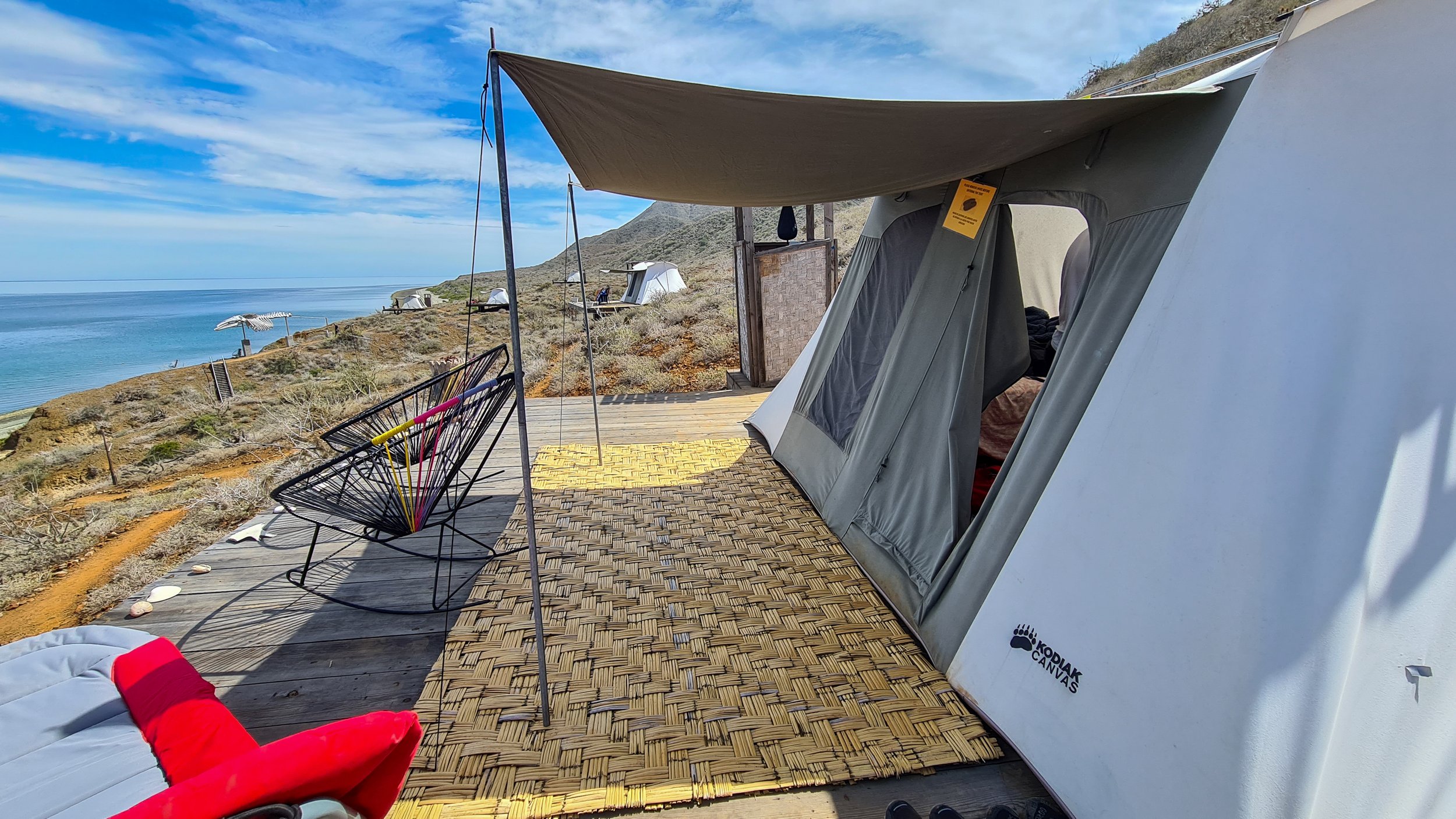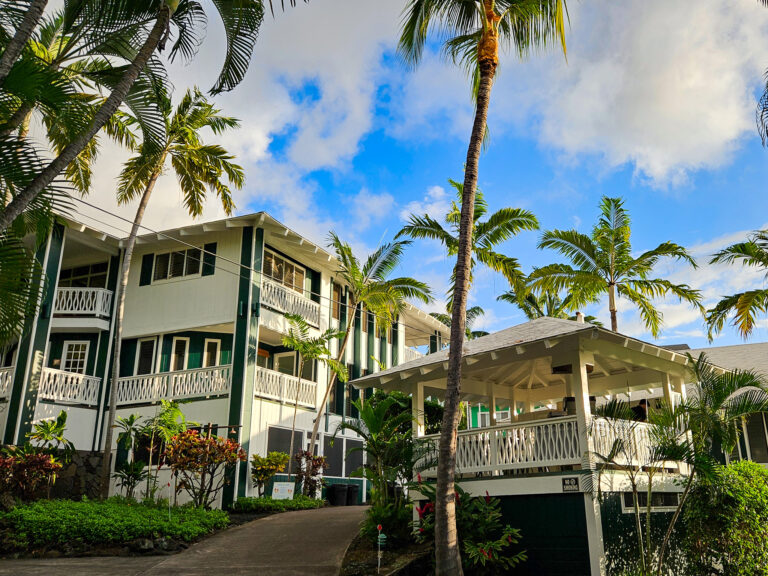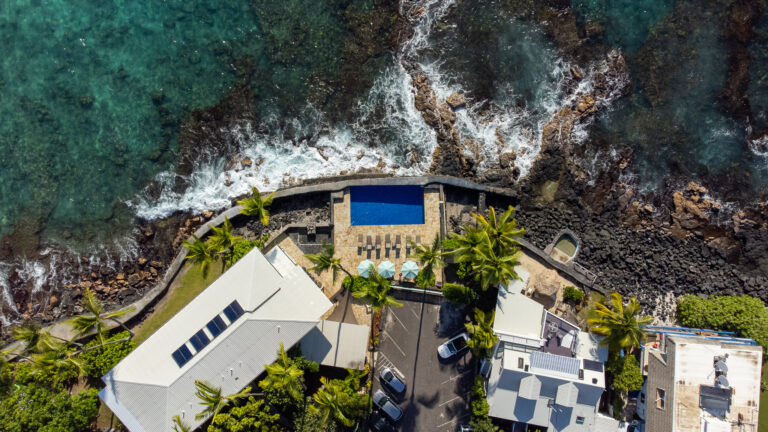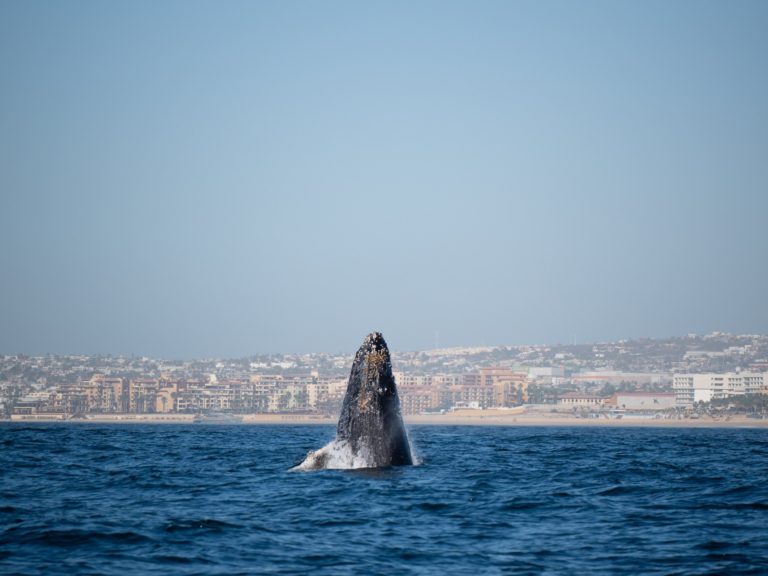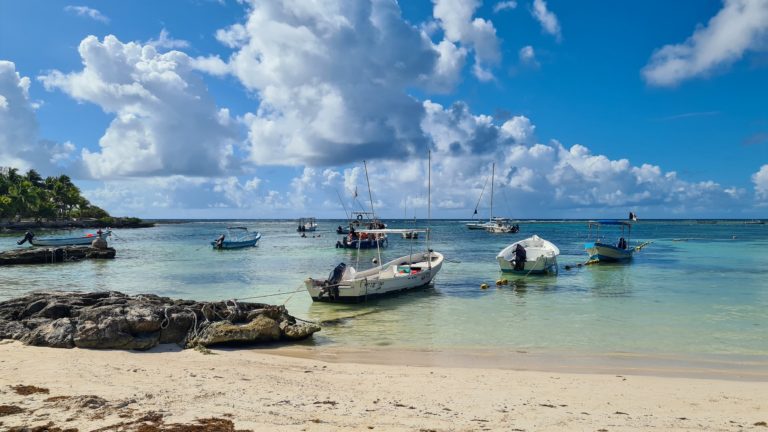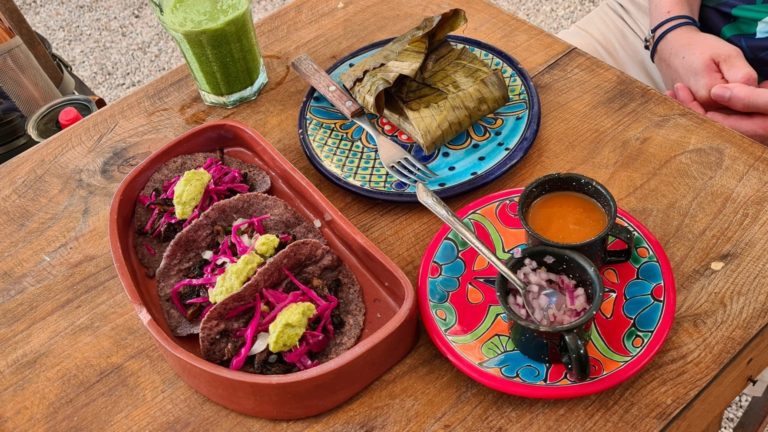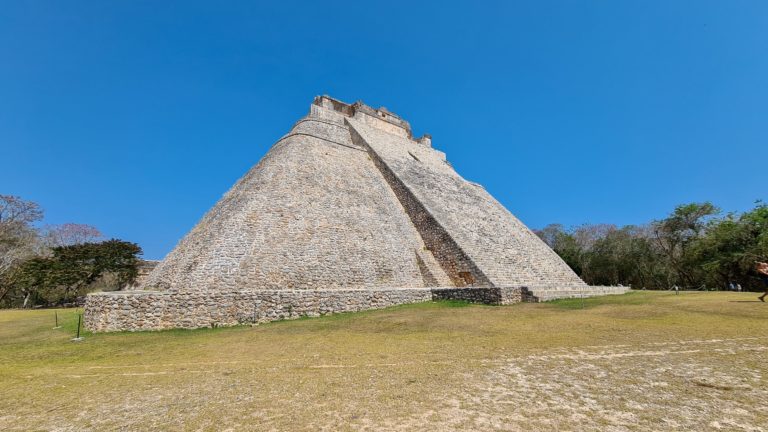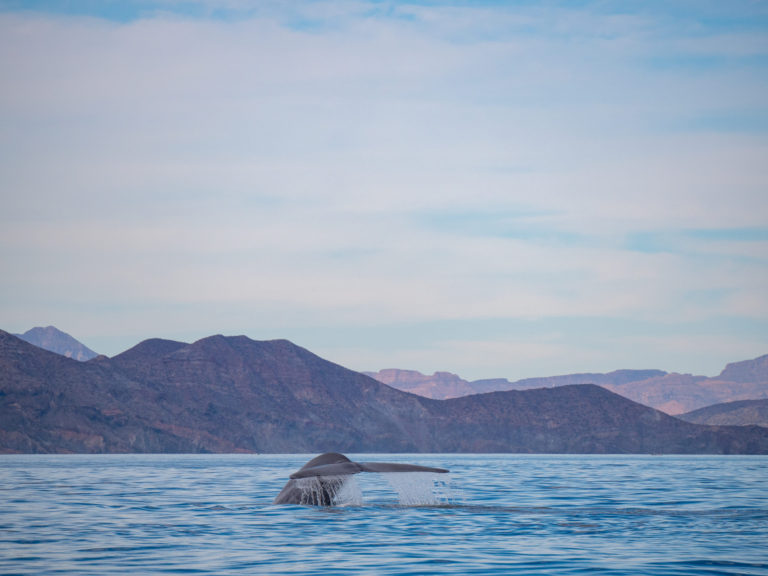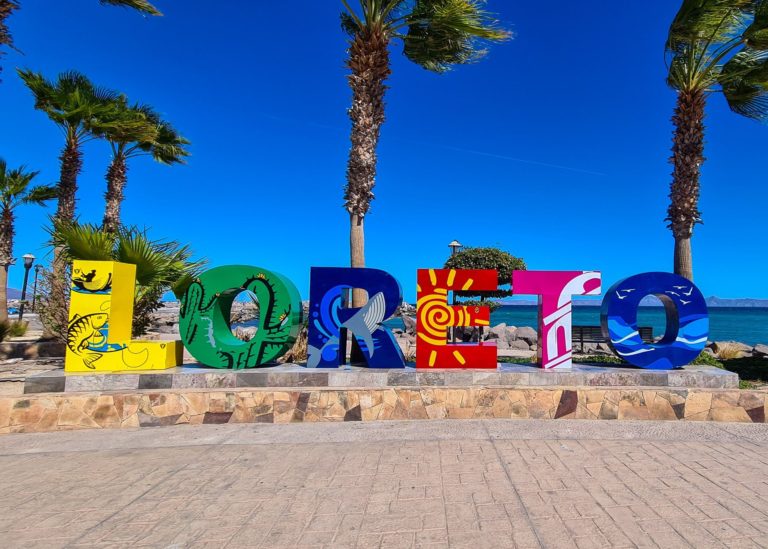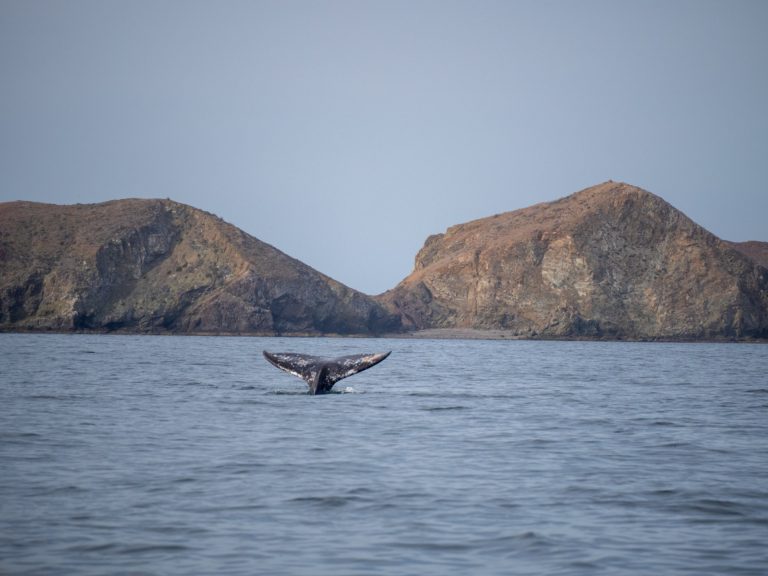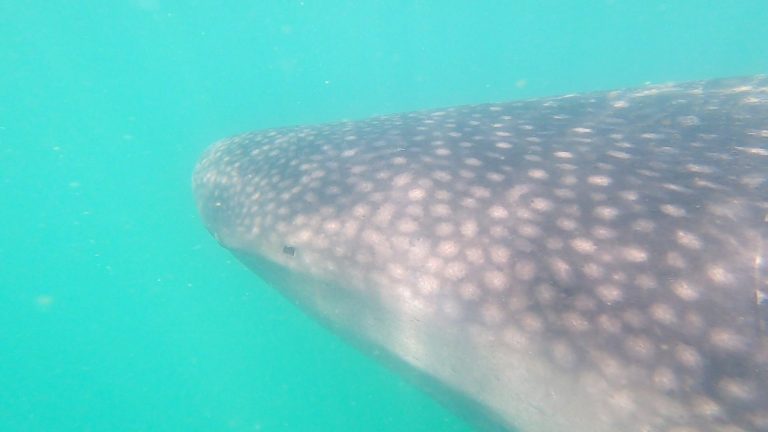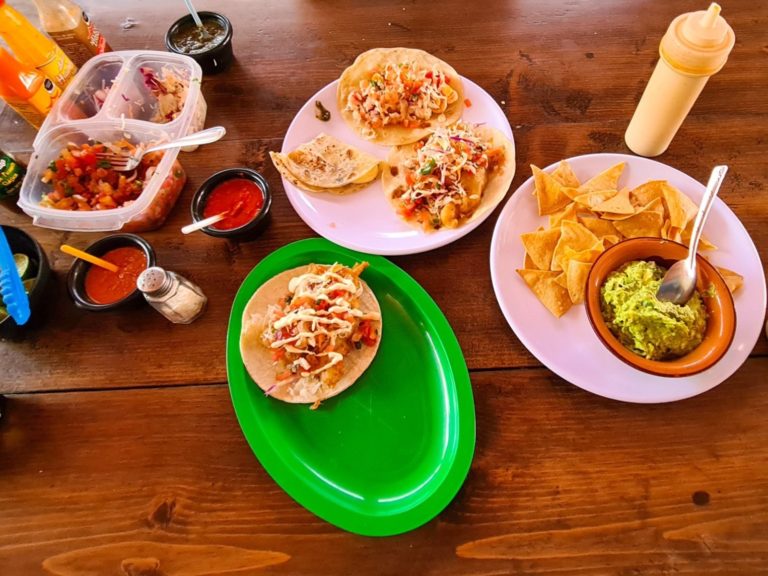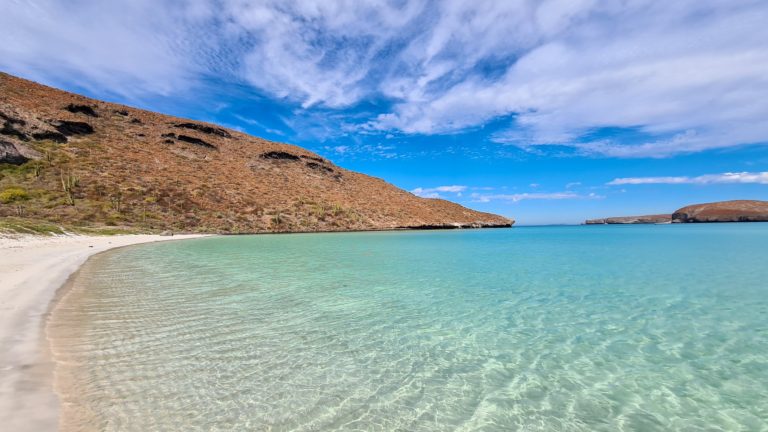The Thorough Guide to Magdalena Bay Whales’ Grey Whale Camp
A complete guide to Magdalena Bay Whale Camp in Baja California Sur – The best place in Mexico to see Grey Whales!
(Updated 2024)
This post may contain affiliate links, which means we might earn a small commission on anything purchased through these links at no extra cost to you. Learn more on our Disclaimer page.
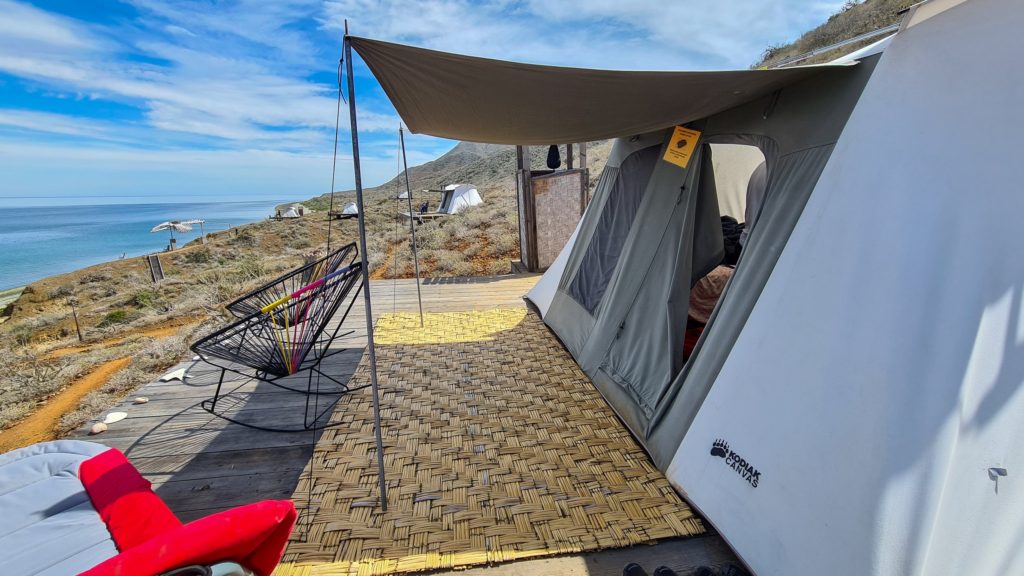
Discover everything you need to know about meeting Baja California Sur’s friendly grey whales in Magdalena Bay, Baja California Sur, with the original whale watching company Magdalena Bay Whales. In this thorough guide, we will give you a run down of what to expect at Magdalena Bay Whale Camp, including the accommodation, logistics, facilities, activities, hikes, meals, and of course the whale watching. We have also included details on how to get to Magdalena Bay from La Paz or Loreto with an interactive map, as well as information on when grey whales visit the bay so that you can perfectly plan your trip for grey whale season in 2024. Let’s get started.
Time needed: 2-4 days.
When to go: December-April for grey whale watching, but February-March for the highest numbers of whales.
Weather: Sunshine is common all year round, with temperatures of 16-23°C in (60-73°F) the winter and 21-32°C (69-89°F) in the summer. The bay can be windy and evenings in winter can be especially chilly.
Language: Spanish, but English is widely spoken too.
Currency: Mexican Peso.

Grey Whale Watching in Baja California Sur
Baja California Sur (BCS) is home to several species of whale, making the peninsula a popular filming location for broadcasters like BBC and National Geographic. Whales can be found up and down both of BCS’s coasts – in the Sea of Cortez and the Pacific Ocean. On the west coast of Baja California Sur sit 3 lagoons, which provide sheltered birthing and breeding grounds for grey whales. Here, between the months of December-April, whales can be found in abundance as they migrate from the cooler waters of the Arctic to the warm waters off the Pacific coast of Mexico.
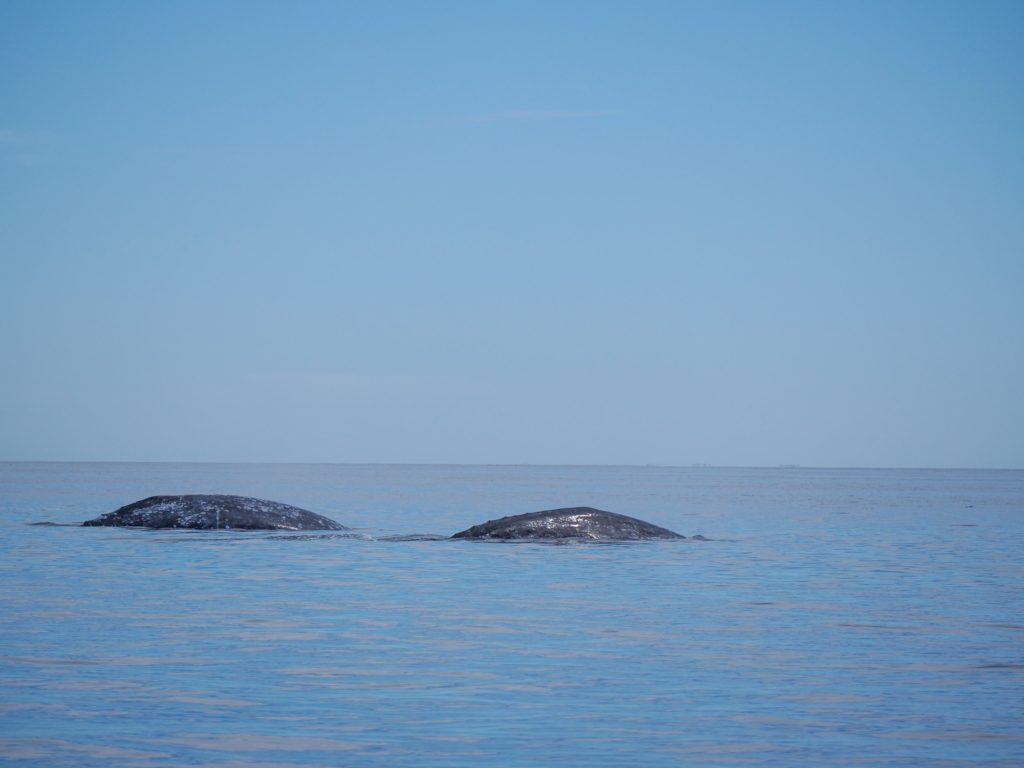
Magdalena Bay Grey Whales
The most accessible lagoon, Magdalena Bay, lies a 3 hour drive from the peninsula’s capital La Paz and a 2 1/2 hour drive from the popular vacation town of Loreto. By far the best and most intimate Magdalena Bay whale watching tour includes staying in the Magdalena Bay Island glamping camp. The owners, Magdalena Bay Whales, are the original Magdalena Bay whale watching tour operator with over 45 years experience operating in the bay. Their camp boasts panoramic views of Magdalena Bay and all the captains are local fisherman who work as guides during whale season. As a small locally-owned company, Magdalena Bay Whales really care for the protection and conservation of grey whales and we’d highly recommend choosing them for your next grey whale watching trip in Baja California Sur.
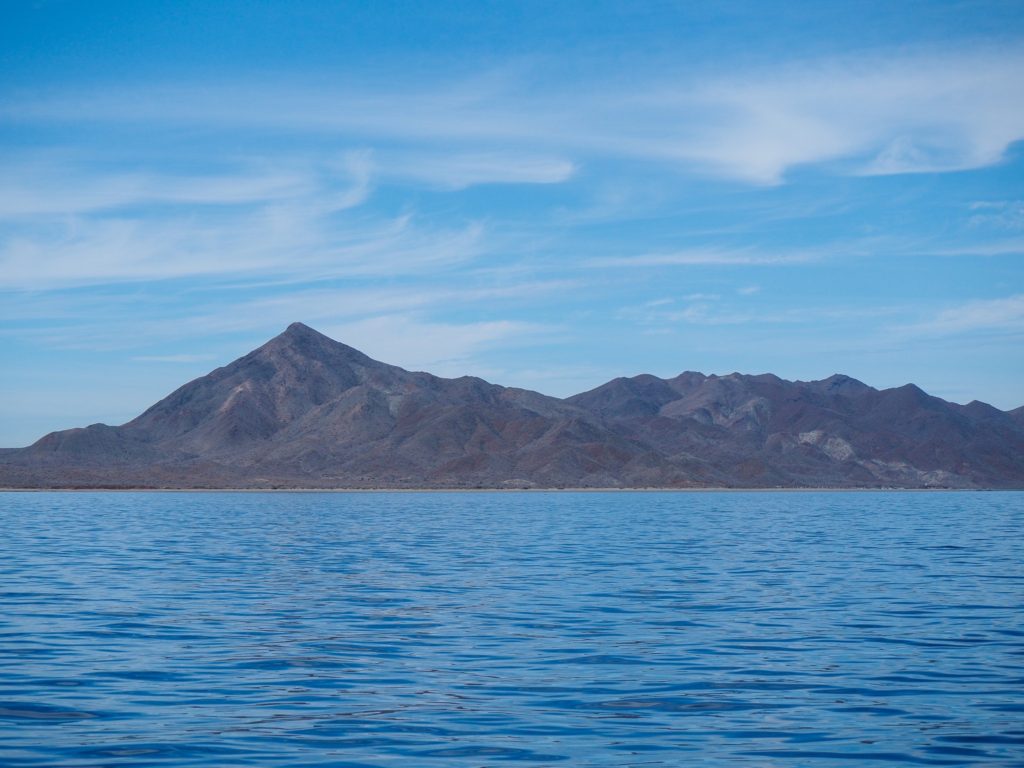
Interactive Magdalena Bay Map
Hotel Isabela, Puerto San Carlos
For most people, a trip to Magdalena Island Whale Camp starts at Hotel Isabela. Situated in the small town of Puerto San Carlos, Hotel Isabela is a small but charming hotel with a traditional Mexican style. There’s not much to do in San Carlos, it’s a tiny town full of dogs with not much else, but the hotel’s palapa-style restaurant is a lovely place to relax with a glass of wine or tequila and the food is delicious. The bed is one of the comfiest we’ve ever slept in, so you can get a good night’s sleep before an early morning boat ride to the island (unless you make friends with other visitors who buy you too much tequila for your birthday and therefore stay up far too late, like we did – thanks Greg and Sheila!).
Magdalena Bay Whales have their office located within the hotel so you’ll likely stop here to meet the team before you head out to the island. It is possible to skip the first night in the hotel and head straight to camp. Just mention this in your communication with Magdalena Bay Whales and they’ll tailor your itinerary to suit you.
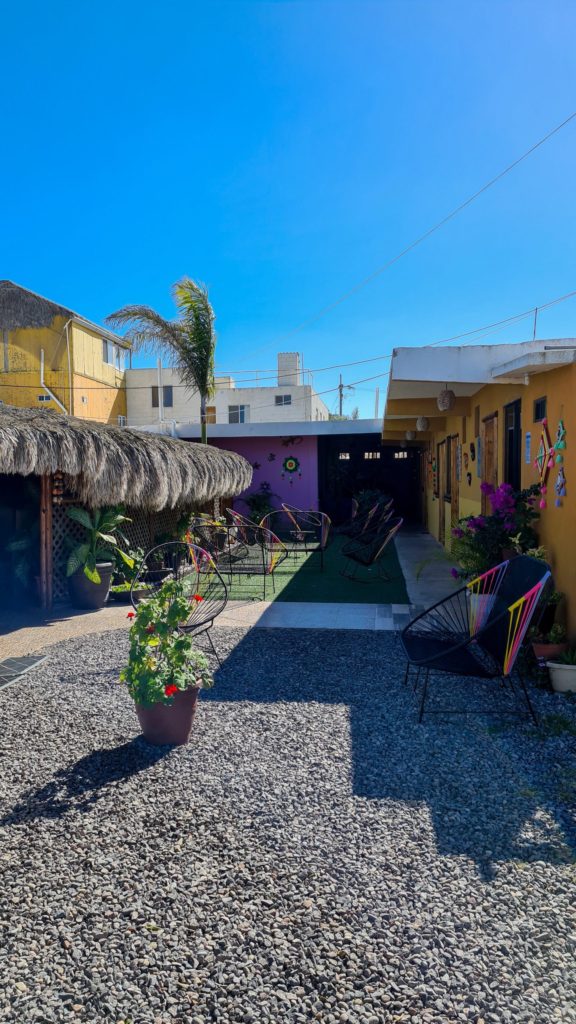
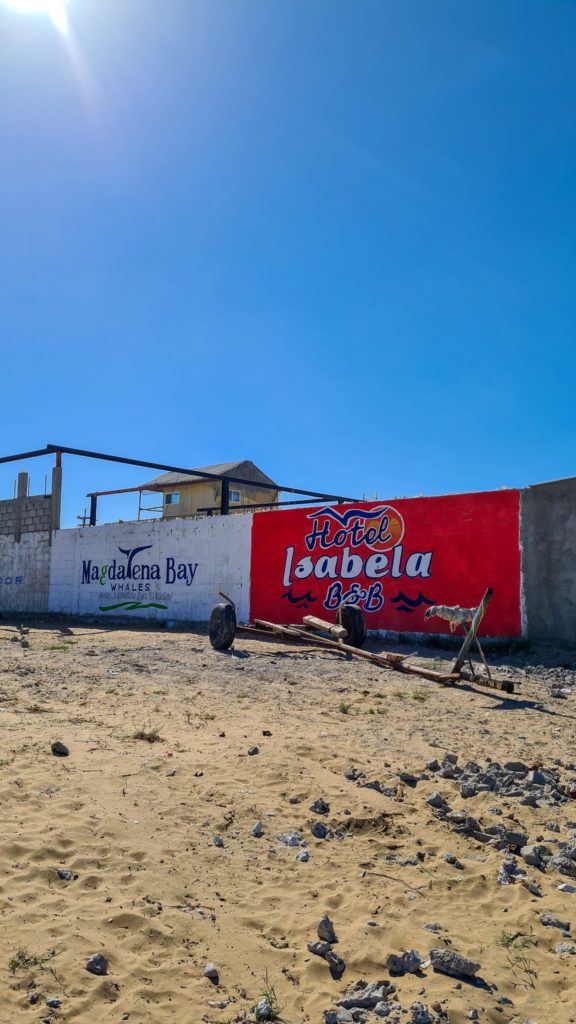
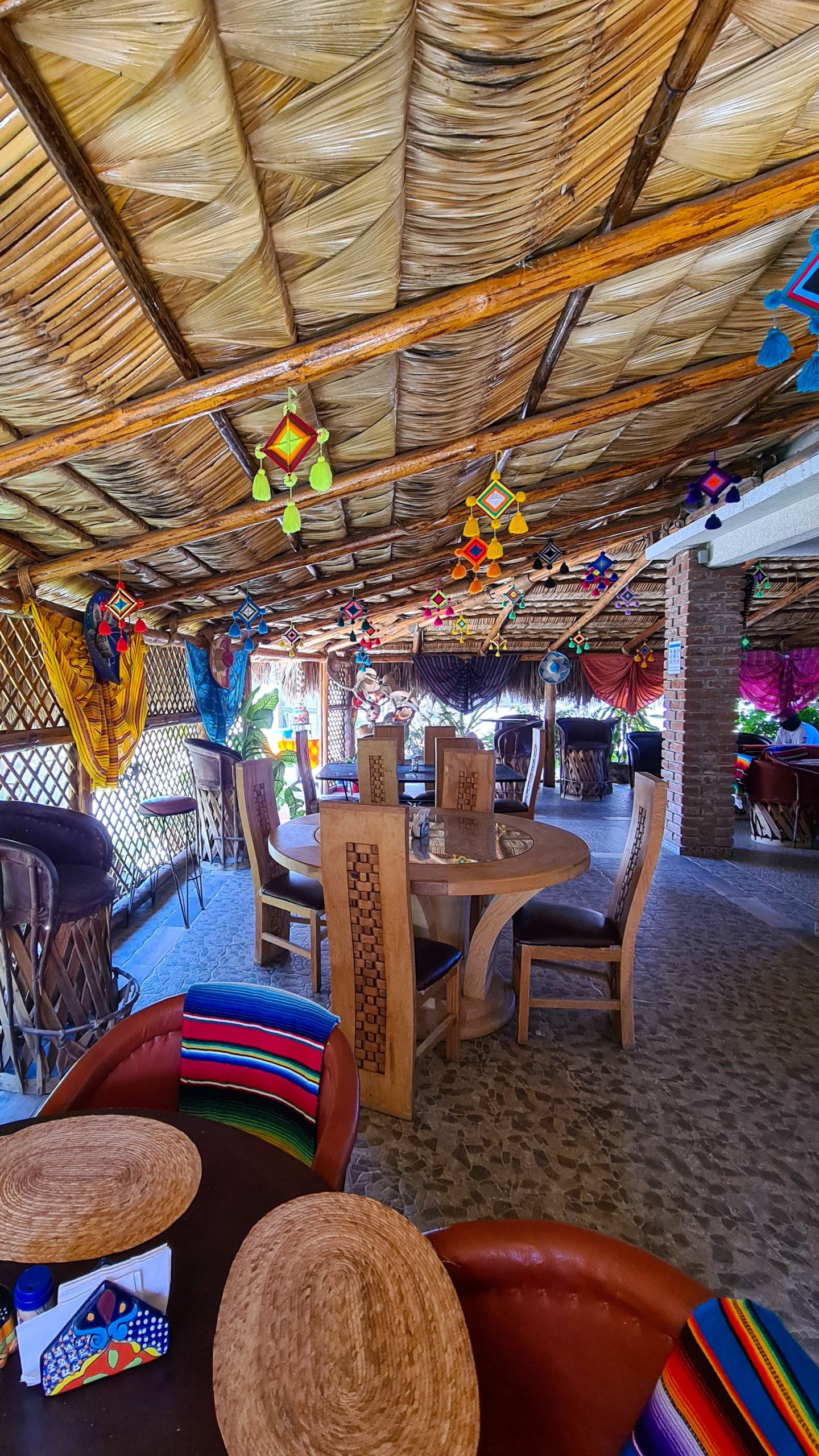
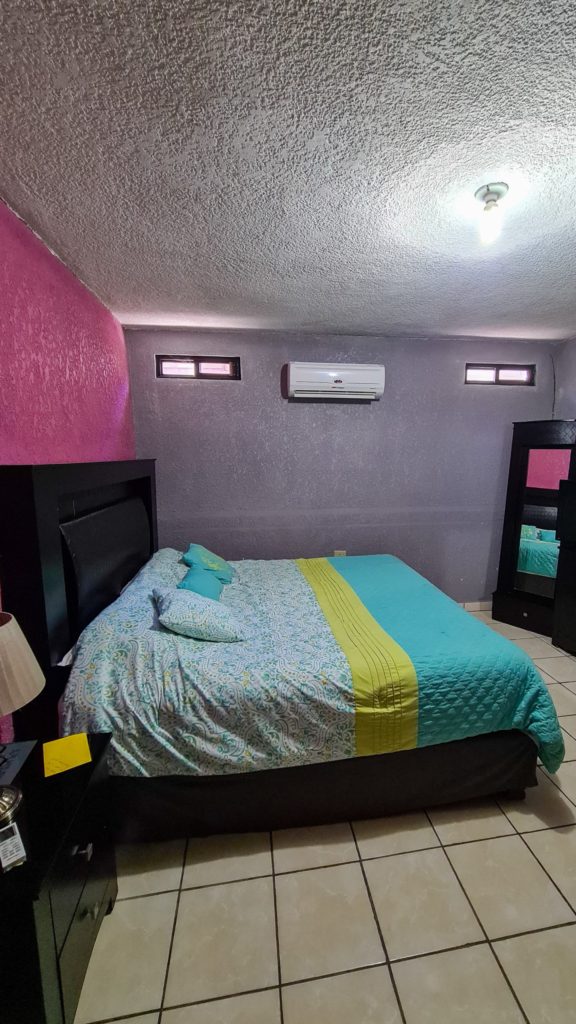
The Magdalena Bay Whale Camp
Magdalena Bay Whales’ Camp is situated on Isla Magdalena – the outer island of Magdalena Bay, which lies on the Pacific Coast of Baja California Sur. The bay is a popular breeding and birthing spot for grey whales, who come here every year between January-March.
The camp itself is set into the hillside and built around a big palapa-style restaurant, where your all-inclusive meals are served. The restaurant features a fire oven, which is the perfect spot to warm up at night with a hot chocolate, as well as lots of seating areas and traditional Mexican blankets. It’s position at the base of camp gives you the perfect view of the sea for whale and dolphin spotting while you eat. There’s also a bar in the restaurant offering local beers and wines (which can be paid for when back on the mainland) and the toilet block is situated just behind the restaurant too. The WiFi in the palapa is excellent and there are lots of charging ports for all your tech so you can go out on the water every day with full camera batteries.
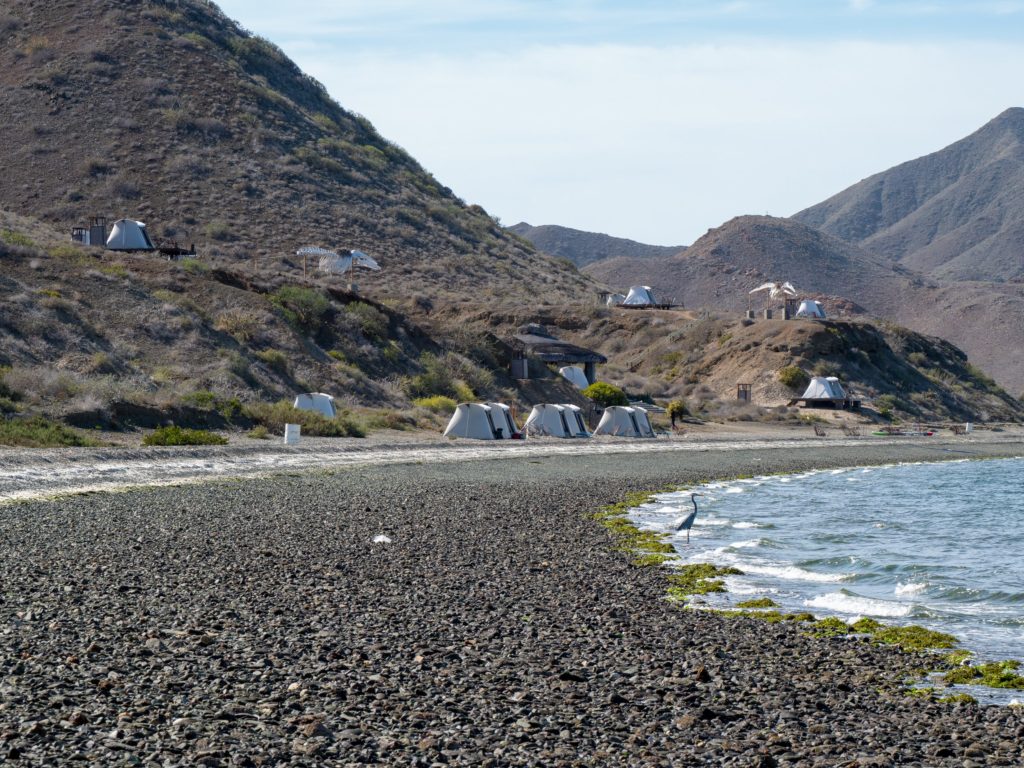
The Glamping Tents in Magdalena Bay Whale Camp
There are two types of glamping tents, some with wooden decks and some situated right on the beach. Each tent has rocking chairs, a camp shower (bag of water heated by the sun), an emergency toilet and some tents have sun loungers too. One of our favourite things to do in camp was sit on our deck watching whales in the bay. We’d highly recommend getting up early each morning and watching the sunrise from your deck. If you’re lucky you may be greeted with a pod of dolphins or the odd whale too!
Inside the tents you’ll find two double beds, a table with map of Baja California Sur, antibacterial gel and spray and a bin. The beds are kitted out with the fluffiest blankets and are super comfy. The temperatures at Isla Magdalena drop considerably at night but you won’t notice because you’ll be snug as a bug in a rug. If you don’t fancy emerging first thing in the morning, you can unzip the window flap and watch the waves lapping at the shore from the comfort of your bed.

There are two washed up grey whale skeletons in camp which have been reassembled, demonstrating the sheer size of a grey whale. During our visit an osprey couple had chosen one skeleton to be their nest and they had 2 babies, which we enjoyed watching from our deck too. Don’t forget to bring a pair of binoculars and a zoom lens for your camera as these can give you a much better view of the local wildlife!
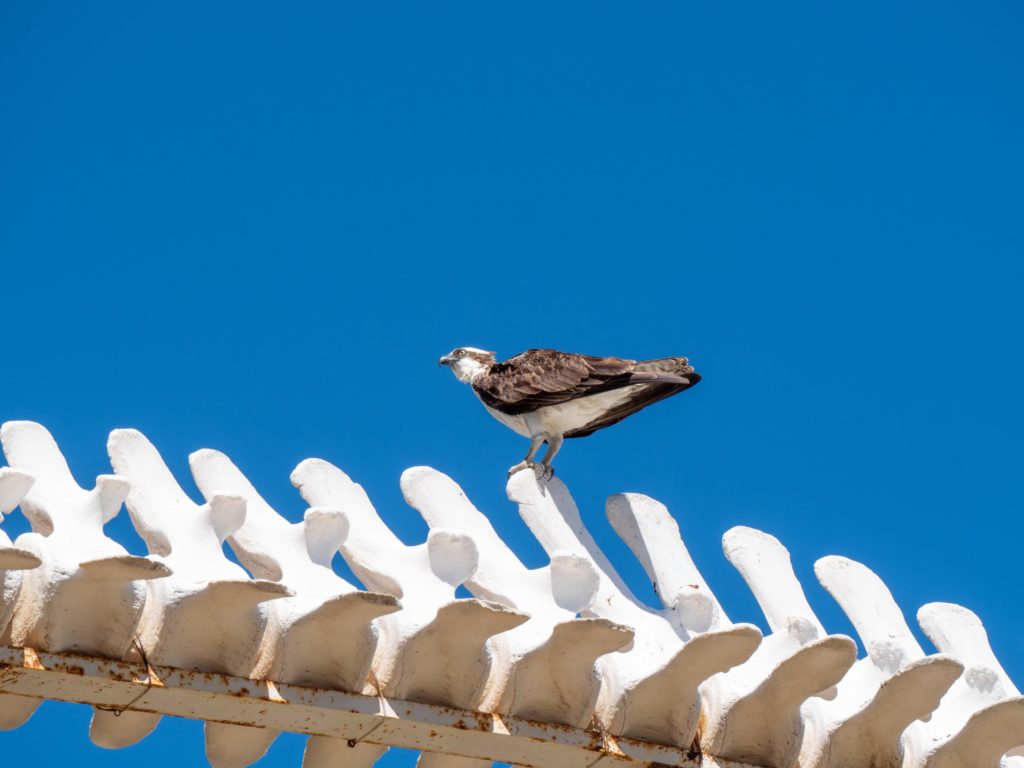
The Food in Magdalena Bay Whale Camp
All 3 meals a day are served in the restaurant. You’re provided with a menu and order whatever you want to eat – it’s all included in the price of camp! And it’s all delicious so you can be assured you’ll be well fed. We’d recommend getting chilaquiles for breakfast, totopos and ceviche for lunch and fish tacos for dinner. At lunch time, snacks are left out in the buffet area so if you fancy something lighter you can help yourself to totopos, salsa and fresh ceviche. There are plenty of vegetarian and vegan options on the menu too and the staff are nothing but helpful, if you have any specific requests.
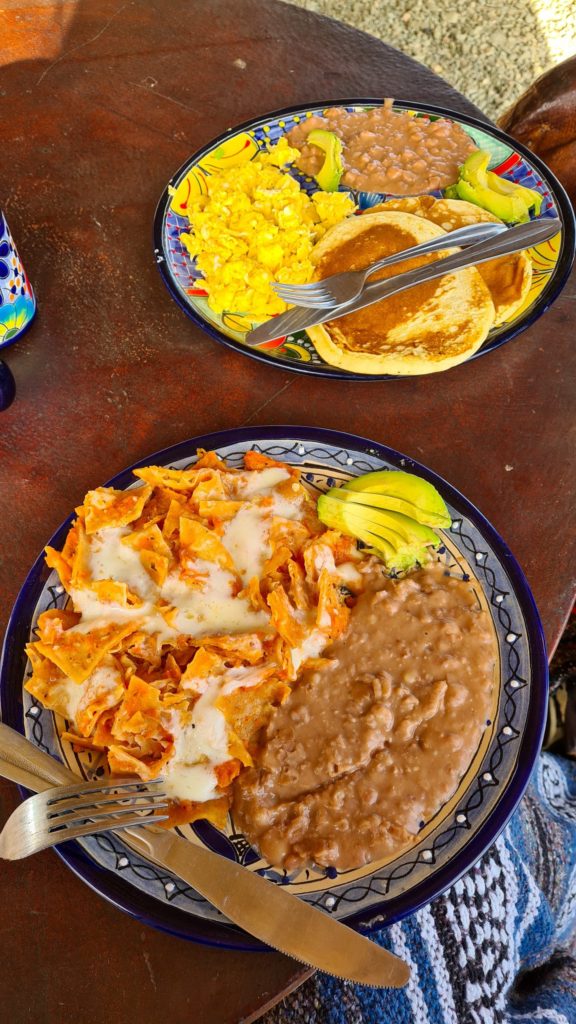
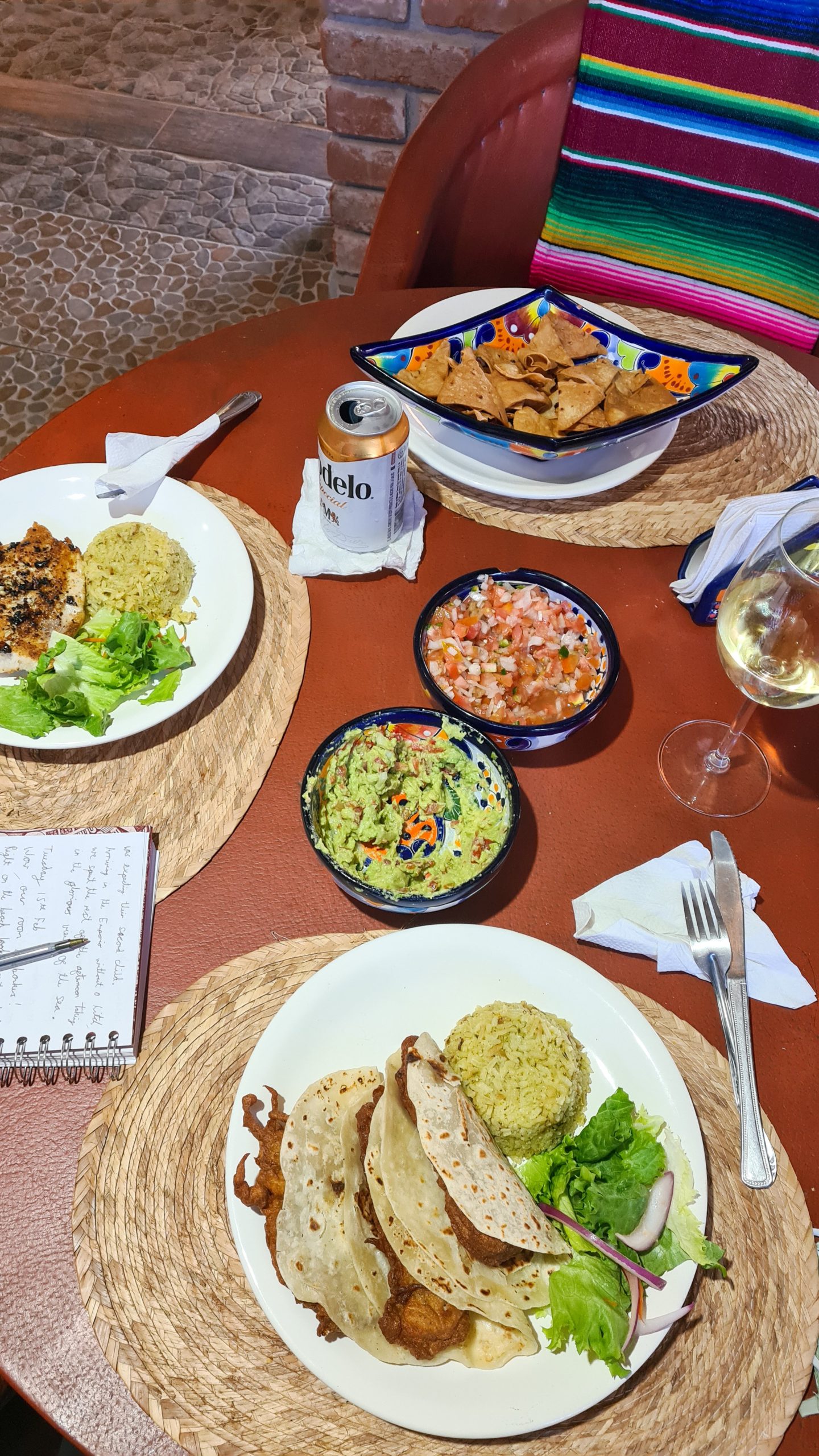
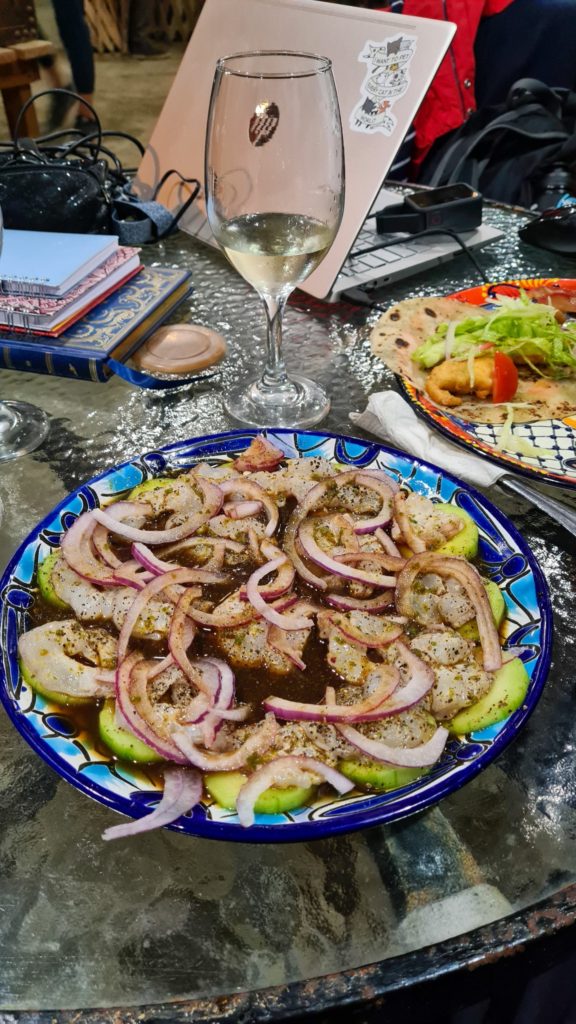
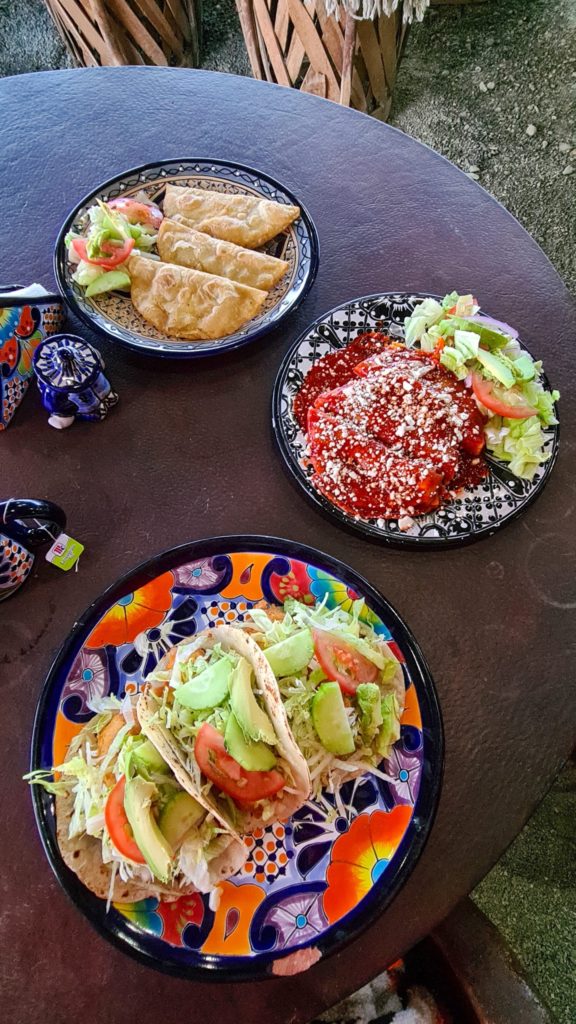
The Sunsets and Sunrises at Magdalena Bay Whale Camp
Magdalena Bay Whales’ Camp offered us some of the best sunrises we’ve ever seen. This one in particular was like waking up to the sky being on fire! In February the sun rose at about 6:50 and set about 18:30 but you can check the times online. We’d recommend getting up about half an hour before sunrise, sitting out on the deck with some blankets and taking it all in. You could even pop down to the restaurant for a cup of coffee or tea to warm up while you watch the sun appear over the horizon. Sunrise and sunset are also the best times for wildlife watching, as this is when most animals are active, and is the time you’ll most likely see dolphins in the bay. We saw a pod of dolphins from our tent on both of our mornings in camp.
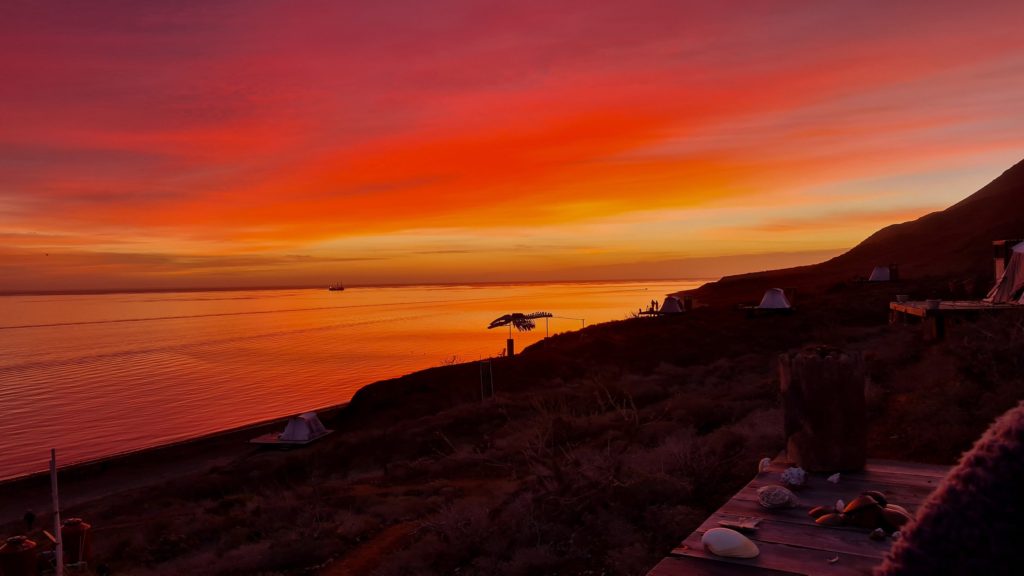
What is there to do in and around Magdalena Bay Whale Camp?
There’s plenty to do in and around camp. There are kayaks and paddleboards for use in the bay, or you can walk up the beach and visit Puerto Magdalena. This little village is only home to around 70 people and all the residents earn an income through fishing in the bay. There’s a little shop (more of a shed with a few products) if you get caught short, bar and restaurant.
You can also explore the sand dunes and mangroves that lie around the bay, many of which are home to some of the 100+ species of birds that call the bay and the surrounding area their home. Your captain will be able to take you out on the boat if you wish to do any of these activities.
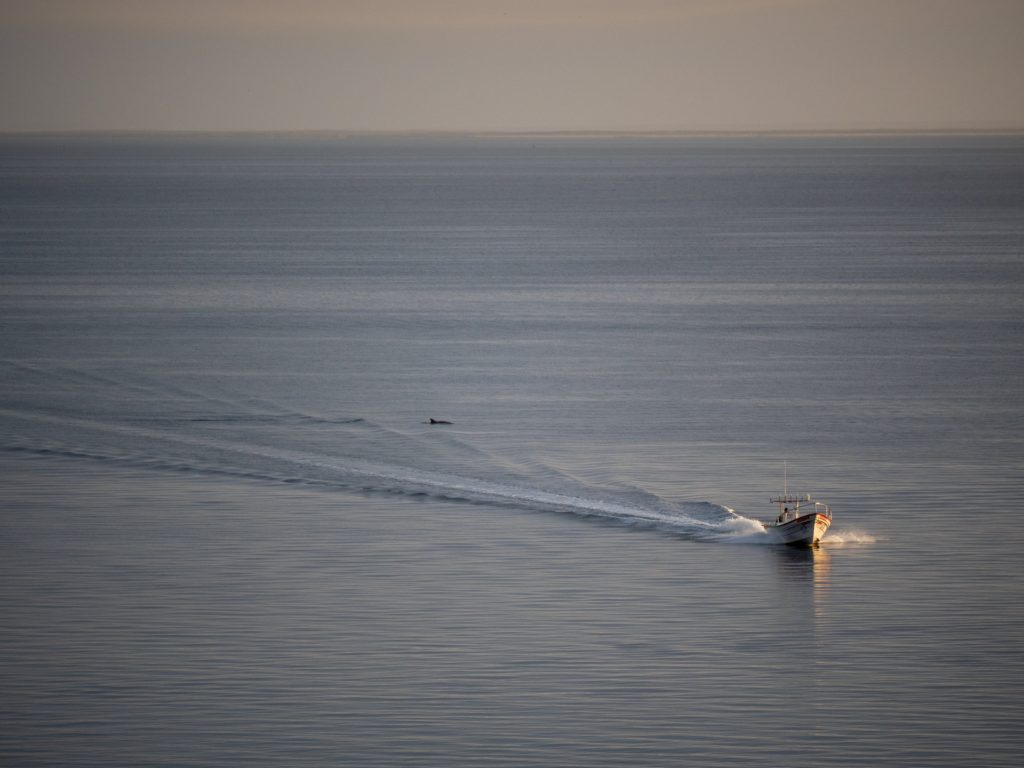
Hiking to the Pacific Ocean from Magdalena Bay Whale Camp
We’d also recommend making time to hike to the Pacific Ocean. The trail can be found 5 minutes from camp and is marked with a small sign (pictured below). The hike takes about half an hour each way and follows a dried up river bed. Wear sensible shoes and take lots of water because it’s a little rocky in places and can get very hot. The path is an easy-moderate hike and is uphill on the way there and downhill on the way back.
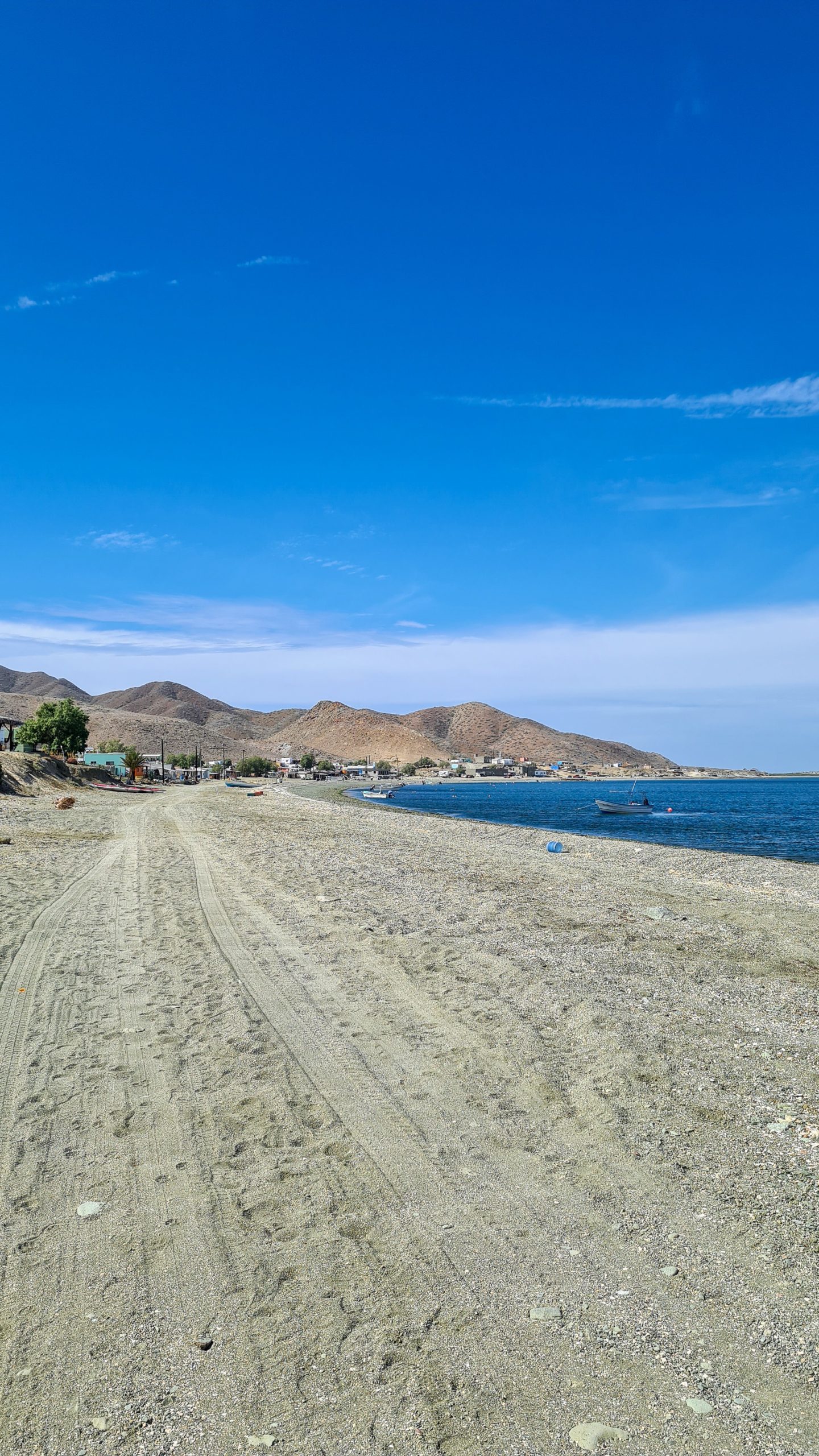
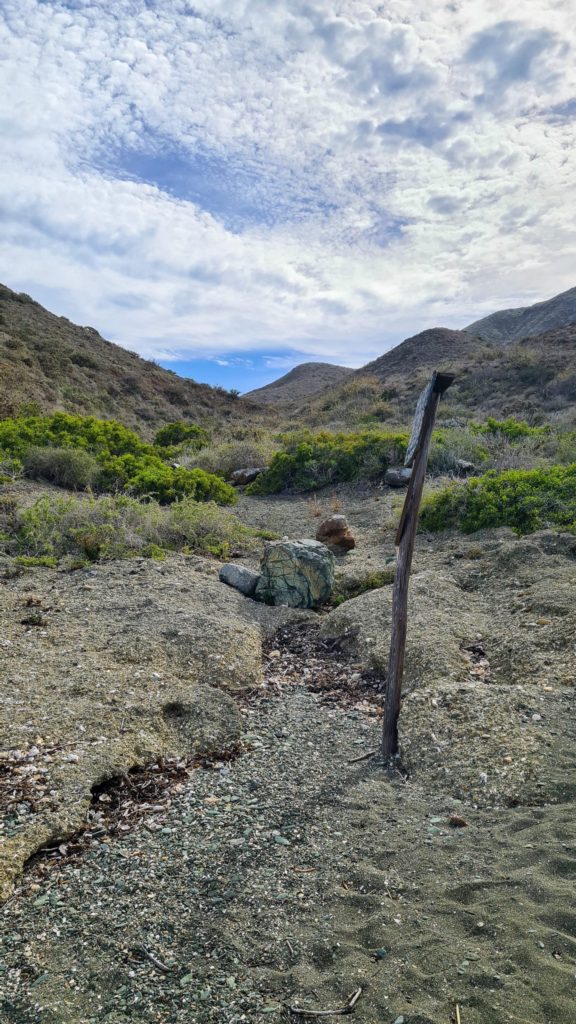
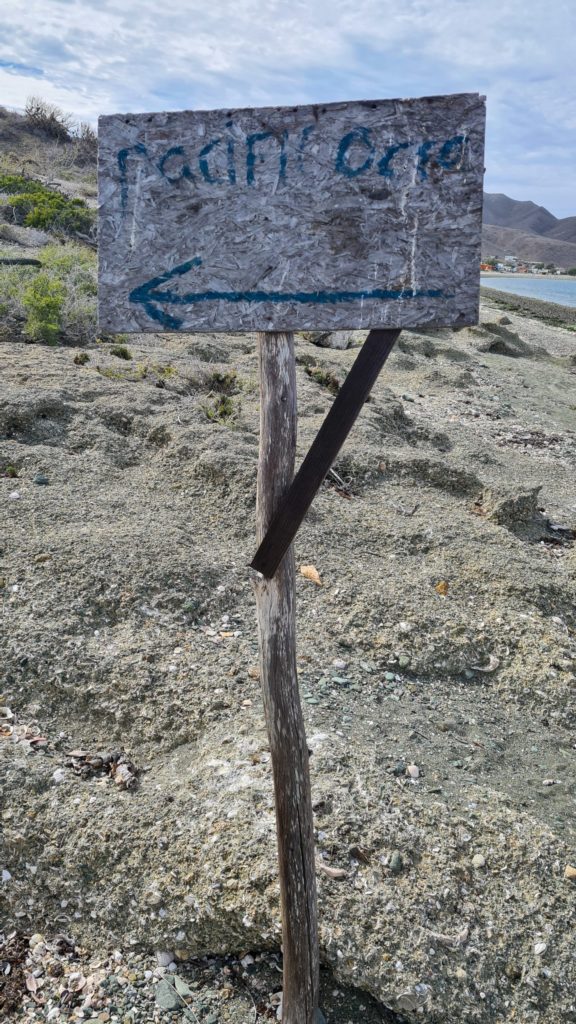
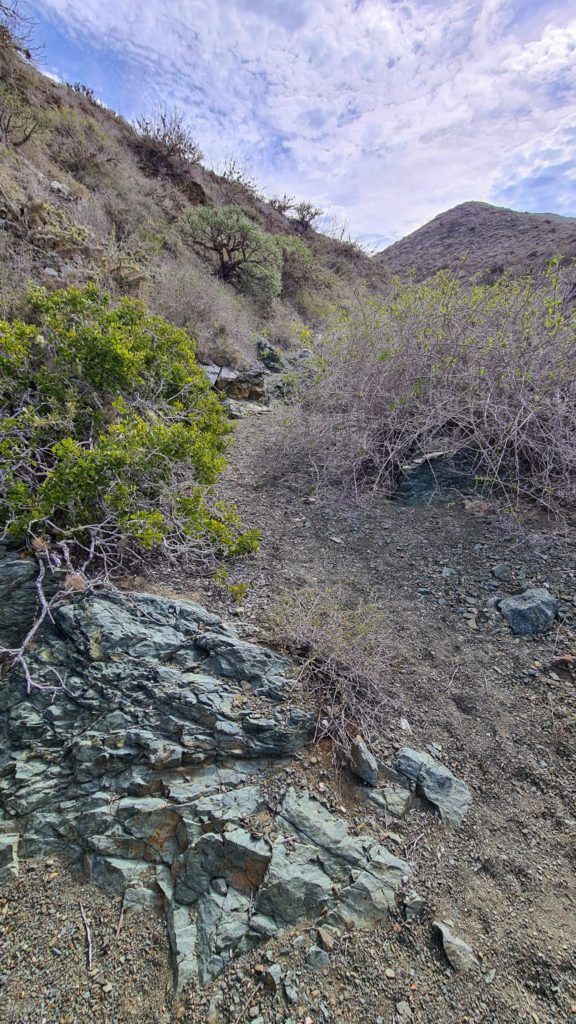
At the Pacific, you’ll be met with stunning panoramic views. You can take the steep path down to the ocean where you’ll find a little rocky beach. Keep a look out towards the sea as we also spotted a whale swimming past the headland when we were there.
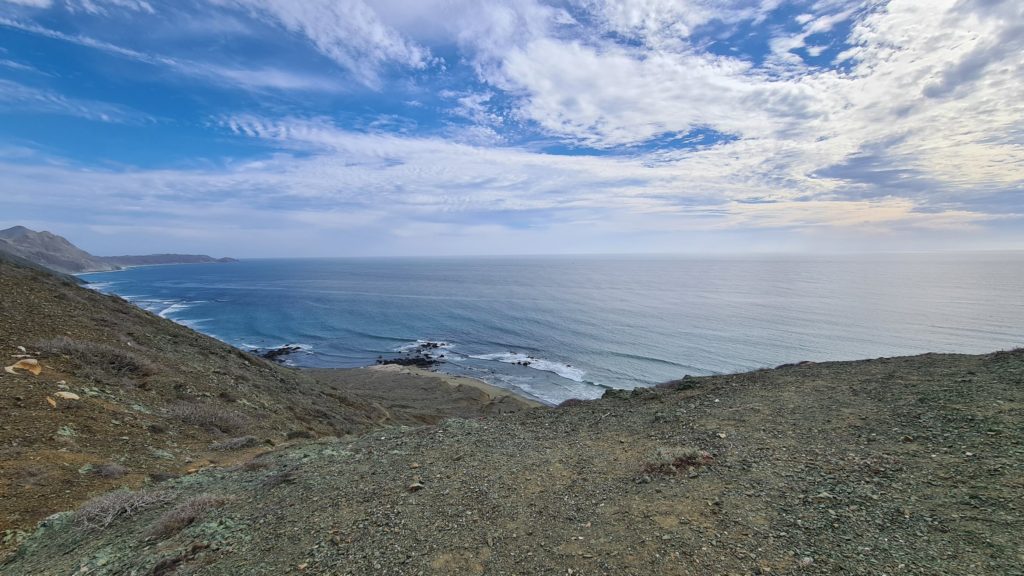
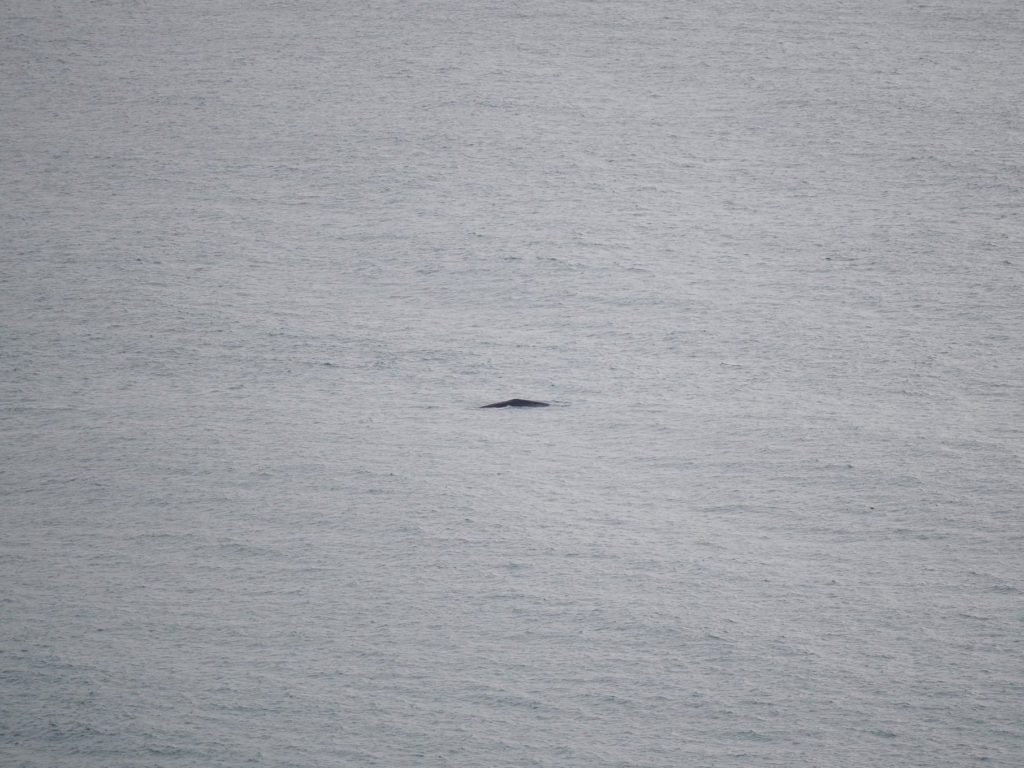
The Magdalena Bay Whale Watching Trips
On each day of camp you get a private whale watching tour. You’ll be assigned a Captain who takes you out into Magdalena Bay to watch the grey whales for about 6 hours at a time. We were there in the peak of the season and there were roughly 60-70 whales in the bay. Due to how still the water was, you could see them blow from miles away. If you’re lucky you’ll also witness behaviours like spy-hopping (bobbing head out of the water), breaching (jumping from the water), tail slapping, fluking (showing tail as the whale dives) and sleeping at the surface. It’s also possible to see other species of whale within Magdalena Bay and around the area where the bay meets the sea. We twice saw humpbacks in Magdalena Bay, including a mother and small calf.
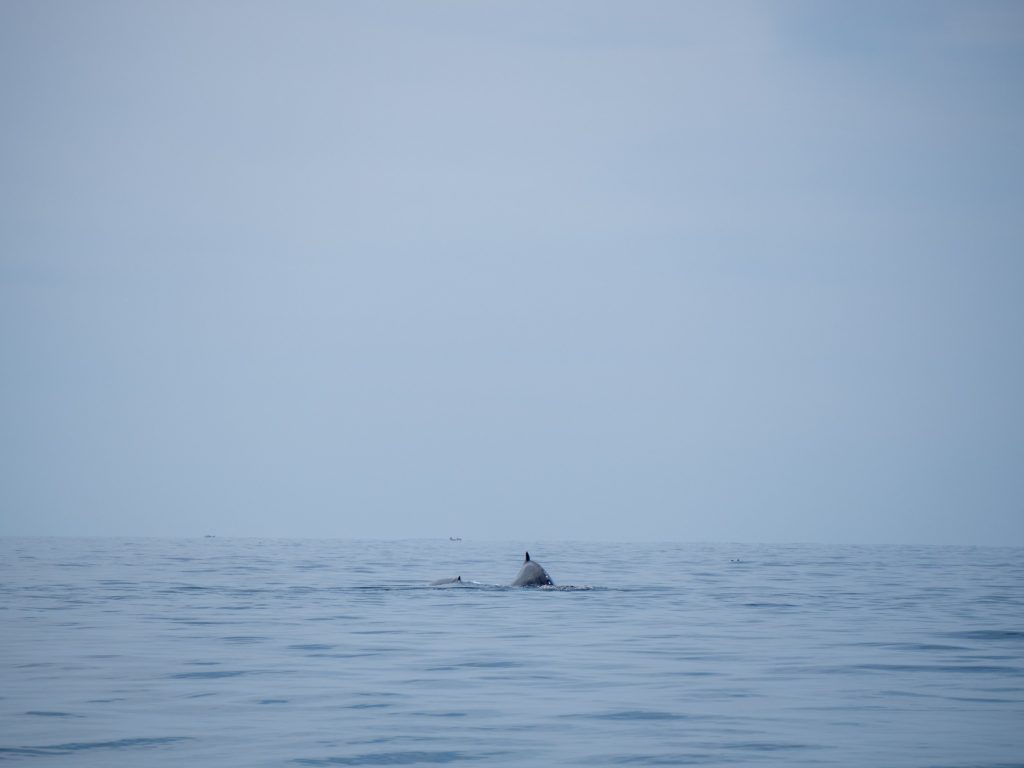
Grey Whale Watching at Magdalena Bay Whale Camp
Baja California Sur is the only place in the world where you can actually touch grey whales, due to their friendly nature and unusually curious behaviour. The grey whales in Magdalena Bay may actually approach boats, seeking human interaction. It’s said that the whales forged a special relationship with the local fisherman, coming to recognise and trust them. The whales became so comfortable that they would come up to the boats and even introduce their young to visitors.
During our visit, we had whales come right up to our boat, swimming underneath the boat, spy-hopping and showing playful behaviour like tail flicking. To experience this you need to find a quiet spot in the bay where the whales feel safe, which is why choosing a licensed company with respectful captains is very important. A wildlife experience built on trust, respect and consent will be better for tourists and whales alike.
Read next: Should you touch a Grey Whale in Baja California Sur?
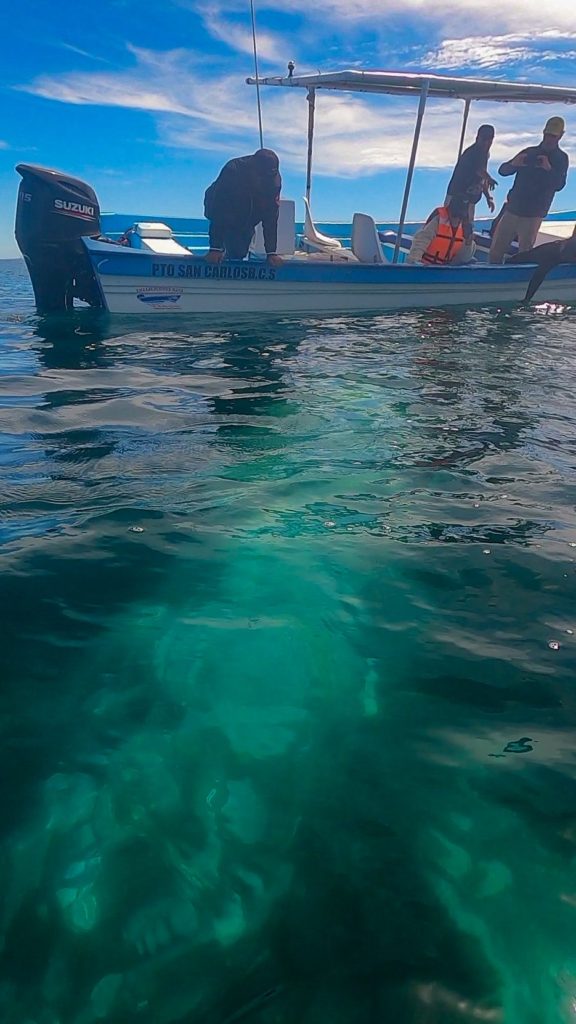
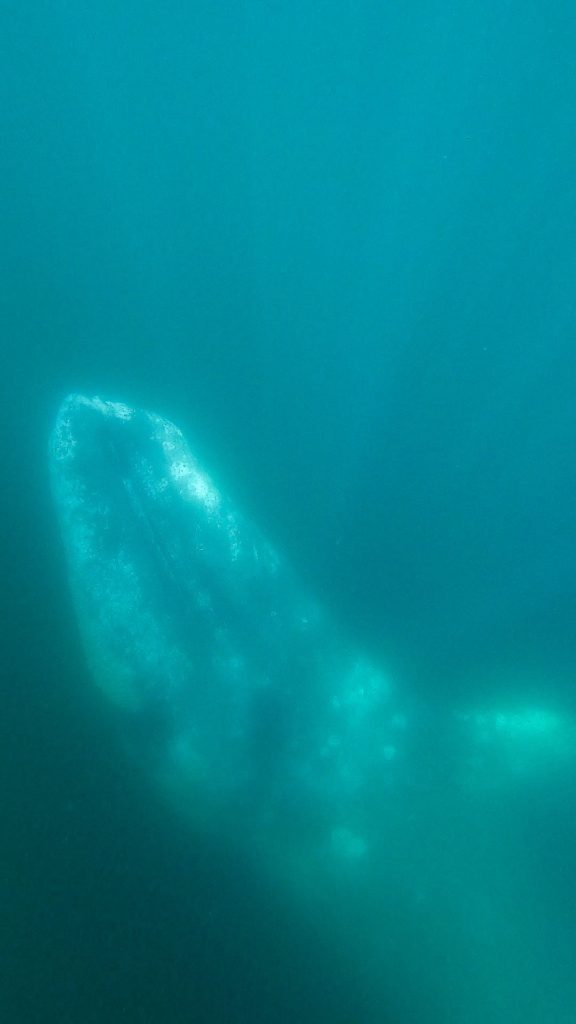
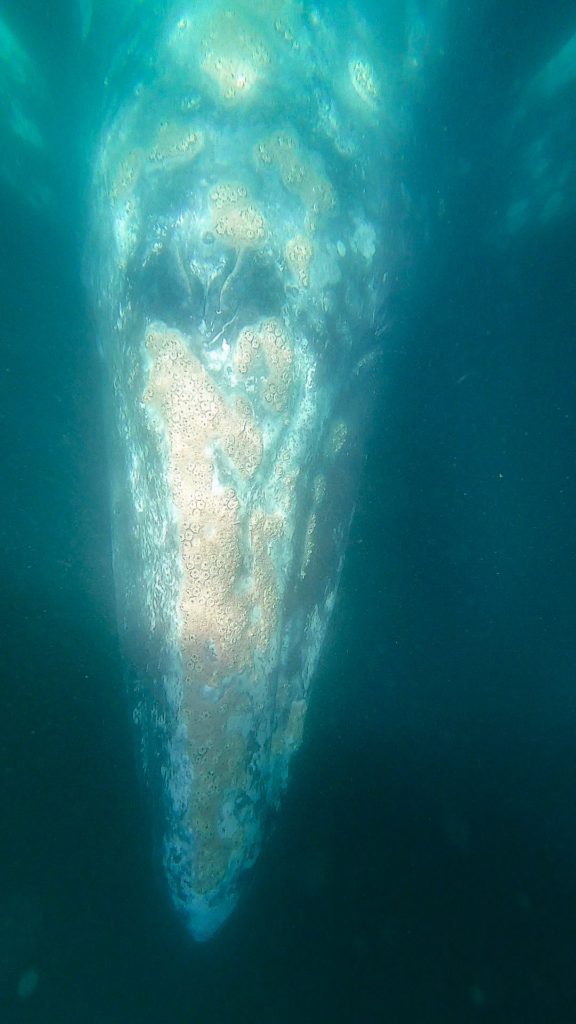
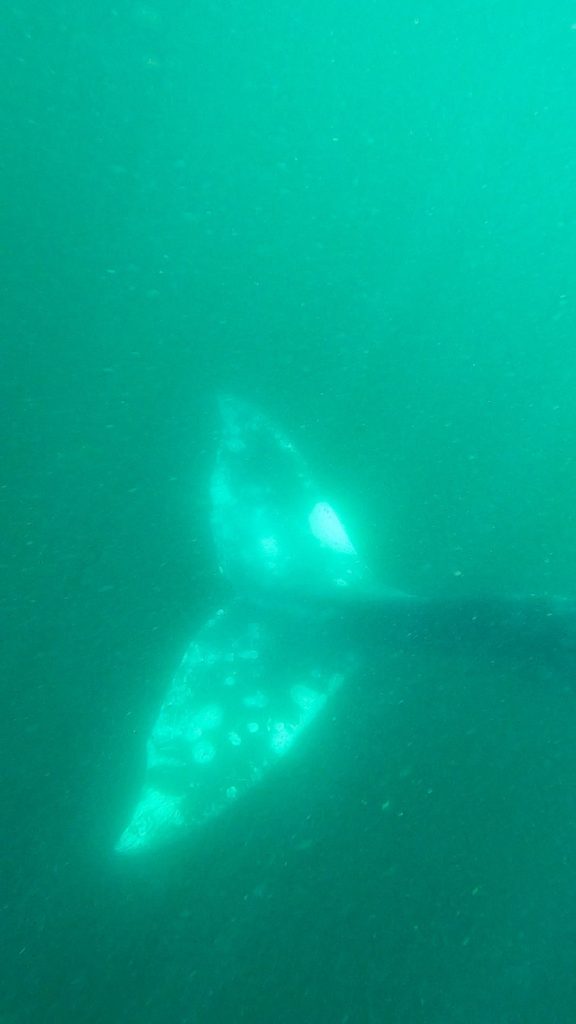
The Magdalena Bay Whale Camp Guides
Magdalena Bay Whales’ guides are local fishermen who know the bay like the back if their hand. Our guide spoke great English and was incredibly knowledgeable about the whales and the surrounding area. We learned so much about grey whales and their habits, as well as other wildlife in the bay and its history.
What we appreciated most was our guide’s obvious care for the whales. He would drive slowly towards a spot where a whale had blown, turn off the propeller and use the oar when around a whale, so as not to bombard it with sound. He would never join a group of boats or crowd the whales. We learned he served as the Director of Tourism and Ecology in BCS for 3 years and still regularly attends meetings about protecting the grey whales. When we noticed boats that were unlicensed or displaying unethical practices (like driving too fast or crowding around a whale) he would film and take photos to report back to the government. These reports hopefully put pressure on the government to regulate the bay better, or tighten the restrictions further.
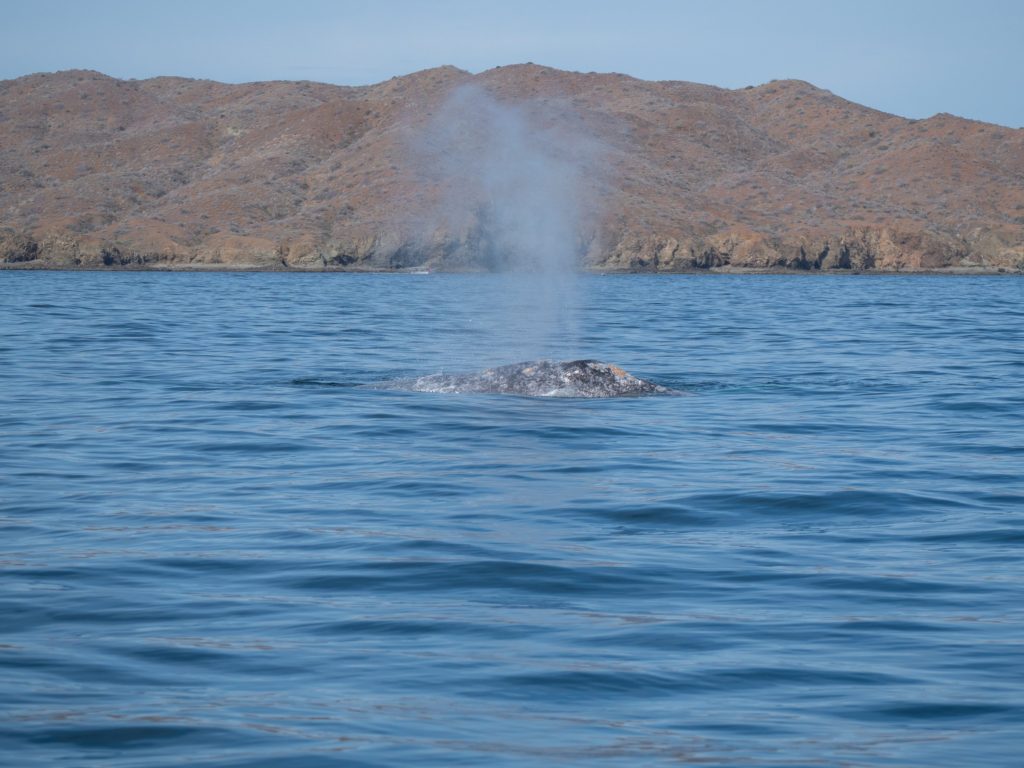
Can you touch Grey Whales in Magdalena Bay?
For unknown reasons, grey whales are some of the friendliest cetaceans on earth. Usually touching animals in the wild is a big no. It can disrupt them, stress them out, transfer harmful bacteria and put you at risk of injury. But the grey whales are an exception (and we researched this endlessly to be extra sure it was ethical). Some grey whales are super curious and will rub against boats, display playful behaviour, pop their heads out of the water and actually enjoy human contact. It’s for this reason that tourists flock from all over the world for the chance to touch and kiss a grey whale in Baja California Sur.
Not every whale is like this and you have to wait until an interested whale approaches your boat. There are quite tight regulations within the bay too. Whales are a bit like buses, you wait for a while for one and then three come along at once! There was nothing more exciting than watching a whale slowly make it’s way towards your boat, wondering if it wanted to play.
Read next: Let’s Talk About Ethical Wildlife Tourism
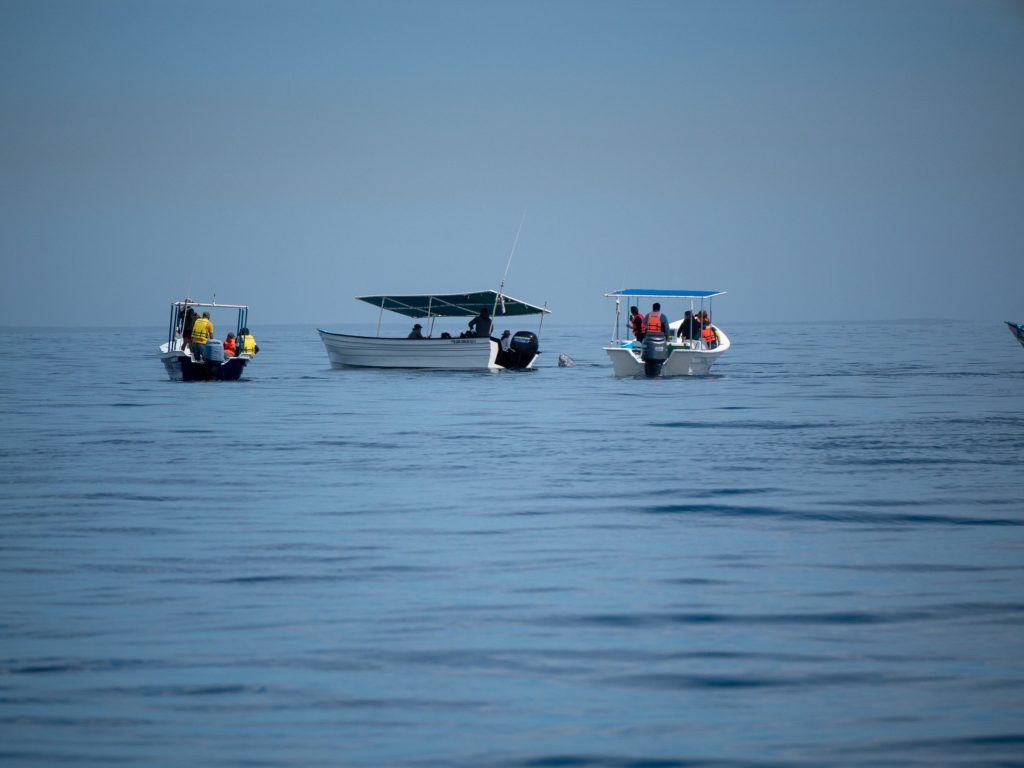
Are there other animals in Magdalena Bay?
Yes there are lots of other species which you’ll probably see when out on the boat.
As if grey whale watching couldn’t get any better, on our final day we came across this massive pod of common dolphins on our way back to camp. It was difficult to count how many there were, but we think at least 100. We actually tried to take trips out to see common dolphins twice in 2021. Common dolphins can be found off Pembrokeshire and Dartmouth (UK) but both times our boat trip was cancelled due to bad weather. So we count this as third time lucky!
Below is a picture of a Brown Pelican, the smallest of the 8 kinds of pelican. It feeds by diving head first into water and it eats small fish. You can tell this one is a juvenile due to its plain brown colour. As it grows it will develop a white and yellow neck and head as well as red on it’s pouch and beak. The different colours indicate whether the bird is a nonbreeding, pre-breeding or breeding adult. They can be found all over Mexico in coastal areas.
And of course we can’t not mention the cheeky sea lions. They hang around Magdalena Bay in clusters (colonies). They’re very curious creatures and enjoy playing in the wake of a boat. When they are not playing, they are generally lazy and enjoy sunbathing on the surface of the water.
Read next: Snorkelling with Sea Lions in La Paz
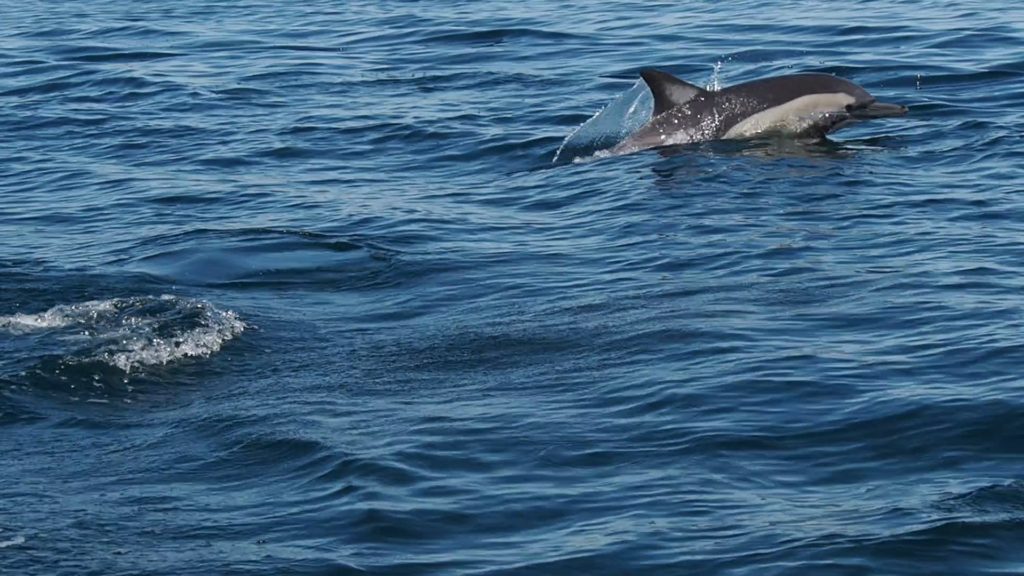
How does the Magdalena Bay Whale Camp work?
Every Magdalena Bay Whales itinerary is adjustable and fully personalised to you. You can contact Magdalena Bay Whales via email or by phone and work out a plan to suit your needs and interests. We had transport included, different pick up and drop off locations and could specify how many nights we wanted in camp. You also get a 6 hour private whale watching tour on each day with a knowledgeable captain so you can get up close and personal with the friendly whales of Baja.
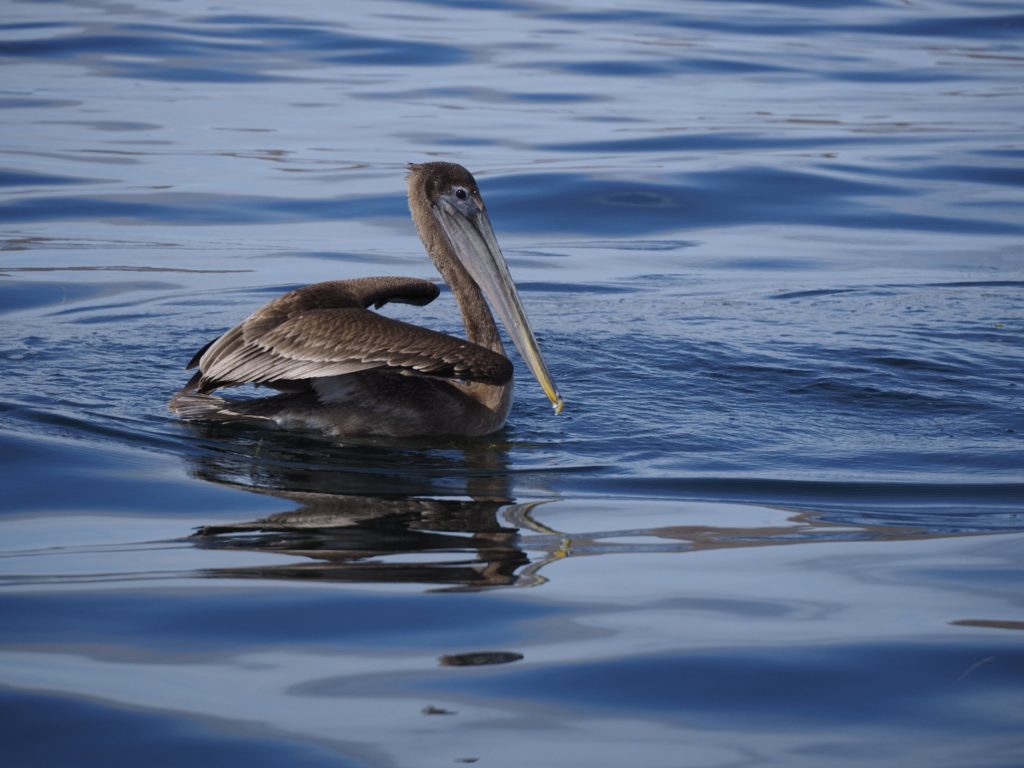
Magdalena Bay Whales Contact Details
Book your stay at Magdalena Bay Whale Camp now!
Website: https://www.magdalenabaywhales.com/
Email: cmarco@magdalenabaywhales.com
Mexico phone number: ( 613 ) 117 7045
Toll free phone number within U.S. & Canada: 1 855 594 2537
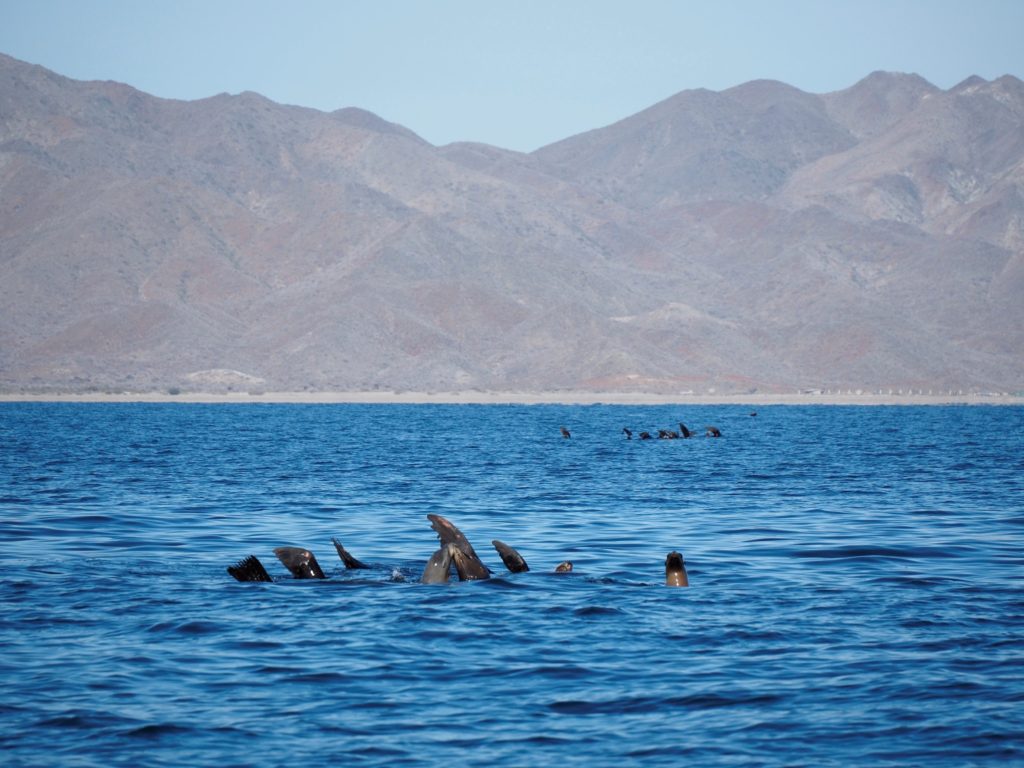
Read next:
Should You Touch a Grey Whale in Baja California Sur, Mexico?
Everything you need to know about Humpback Whale Watching in Los Cabos
Everything you need to know about Blue Whale Watching in Loreto
Everything you need to know about Swimming with Whale Sharks in La Paz
